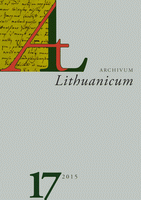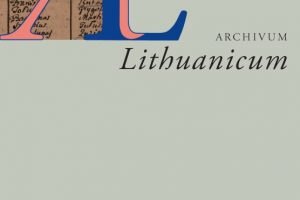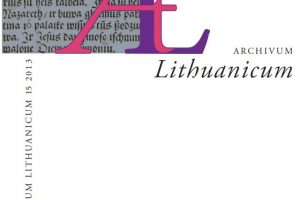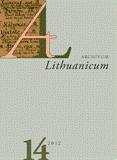Archivum Lithuanicum 17
Klaipėdos universitetas
Lietuvių kalbos institutas
Šiaulių universitetas
University of Illinois at Chicago
Vilniaus universitetas
Vytauto Didžiojo universitetas
Archivum Lithuanicum
Lietuvių kalbos institutas
P. Vileišio g. 5
LT-10308 Vilnius, Lietuva
Prof. habil. dr. GIEDRIUS SUBAČIUS (filologija / philology),
(vyriausiasis redaktorius / editor),
University of Illinois at Chicago
Dr. BIRUTĖ TRIŠKAITĖ (filologija / philology),
(vyriausiojo redaktoriaus pavaduotoja / associate editor),
Lietuvių kalbos institutas, Vilnius
Habil. dr. ONA ALEKNAVIČIENĖ (filologija / philology),
Lietuvių kalbos institutas, Vilnius
Prof. habil. dr. ROMA BONČKUTĖ (filologija / philology),
Klaipėdos universitetas
Prof. dr. PIETRO U. DINI (kalbotyra / linguistics),
Università di Pisa
Prof. habil. dr. JOLANTA GELUMBECKAITĖ (kalbotyra /
linguistics),
Johann Wolfgang Goethe-Universität Frankfurt am Main
Dr. REDA GRIŠKAITĖ (istorija / history),
Lietuvos istorijos institutas, Vilnius
Doc. dr. BIRUTĖ KABAŠINSKAITĖ (filologija / philology),
Vilniaus universitetas
Prof. habil. dr. BRONIUS MASKULIŪNAS (filologija / philology),
Šiaulių universitetas
Doc. dr. JURGIS PAKERYS (filologija / philology),
Vilniaus universitetas
Prof. habil. dr. RŪTA PETRAUSKAITĖ (filologija / philology),
Vytauto Didžiojo universitetas, Kaunas
Habil. dr. CHRISTIANE SCHILLER (kalbotyra / linguistics),
Humboldt-Universität zu Berlin
Prof. dr. WILLIAM R. SCHMALSTIEG (kalbotyra / linguistics),
Pennsylvania State University, University College
Habil. dr. DARIUS STALIŪNAS (istorija / history),
Lietuvos istorijos institutas, Vilnius
Dr. MINDAUGAS ŠINKŪNAS (kalbotyra / linguistics),
Lietuvių kalbos institutas, Vilnius
Vilniaus universitetas
Dr. AURELIJA TAMOŠIŪNAITĖ (filologija / philology),
Vytauto Didžiojo universitetas, Kaunas
Dr. JURGITA VENCKIENĖ (filologija / philology),
Lietuvių kalbos institutas, Vilnius
Archivum Lithuanicum 17
Straipsniai (Articles)
Birutė Triškaitė
Lietuviškas XVII amžiaus pabaigos laiškas:
Michaelio Richterio skundas dėl bandomojo pamokslo vertinimo (1698)
Ona Aleknavičienė
Baltramiejus Vilentas, Šteindamo Šv. Mikalojaus bažnyčia, Karaliaučius, 1553–1587
Wolfgang Hock
Untersuchungen zu Daukšas Postille – III . Adjektive auf -us
Mindaugas Šinkūnas
Pirmieji lietuviški Kauno paminėjimai
Philip Kraut
Jacob Grimm und die litauische Sprache – I. Studien und Korrespondenzen
Giedrius Subačius
Ortografinė Simono Daukanto žemaitiško balsio [ẹ] raiška
Istorijoje žemaitiškoje (1828–1834): ‹e, ę, i, y›
Publikacijos (Publications)
Felix Thies
Edition und Kommentar des Buchs Ruth aus
der Bibelübersetzung des Johannes Bretke (1589)
Jurgita Venckienė
Trys lietuviški XIX amžiaus plakatai Čikagos Newberry bibliotekoje
Recenzijos (Reviews)
Jolanta Gelumbeckaitė
Recenzuojama: John M. Frymire, The Primacy of the Postils.
Catholics, Protestants, and the Dissemination of Ideas in Early Modern Germany.
Studies in Medieval and Reformation Traditions 147, 2010
Liucija Citavičiūtė
Recenzuojama: Arthur Hermann u. a. (hrsg.),
Annaberger Annalen über Litauen und deutsch-litauische Beziehungen 22.
Kristijonas Donelaitis / Christian Donalitius 1714–1780, 2014
Rūta Lazauskaitė
Recenzuojama: Giedrė Jankevičiūtė, Mikas Vaicekauskas,
Visagalė tradicija: Kristijono Donelaičio poemos Metai iliustracijos ir vaizdinis
kanonas: Studija = An Omnipotent Tradition: The Illustrations and the Visual
Canon of Kristijonas Donelaitis’s Poem Metai: A Study, 2013
Asta Kazlauskienė
Recenzuojama: Birutė Kabašinskaitė (par.),
Frydrichas Kuršaitis, Lietuvių kalbos garsų ir kirčio mokslas (1849)
[Lietuvių kalbos tyrimai 2], 2013
Regina Venckutė
Recenzuojama: Aldona Paulauskienė,
Svarbesniosios XX amžiaus lietuvių kalbos gramatikos, 2015
Eugen Hill
Rezension von: Pietro U. Dini, Foundations of Baltic Languages,2014
Jan Conrad
Rezension von: Helmut Wilhelm Schaller, Geschichte der Slawischen
und Baltischen Philologie an der Universität Königsberg, 2009
Darius Staliūnas
Recenzuojama: Aldona Prašmantaitė,
1863 metų sukilimas ir Katalikų Bažnyčia Lietuvoje, 2014
Vilma Žaltauskaitė
Recenzuojama: Brigita Speičytė,
Anapus ribos. Maironis ir istorinė Lietuva, 2012
Diskusijos, apžvalgos, pastabos (Discussions, Surveys,
Notes)
Christiane Schiller, Dalia Kiseliūnaitė
Ein nehrungskurischer Text im Forschungszentrum
Deutscher Sprachatlas in Marburg. Das Blatt 30084 Nidden
Ona Aleknavičienė, Birutė Triškaitė
In memoriam: Vincentas Drotvinas (1929–2015)
Giedrius Subačius
In memoriam: Vincas Urbutis (1929–2015)
Birutė Triškaitė
EIN LITAUISCHER BRIEF AUS DEM ENDE DES 17. JH.:
DIE BESCHWERDE VON MICHAEL RICHTER ÜBER
DIE BEWERTUNG SEINER PROBEPREDIGT (1698)
Zusammenfassung
Der vorliegende Beitrag umfasst die Publikation und Analyse eines zurzeit in den Beständen des Geheimen Staatsarchivs Preußischer Kulturbesitz zu Berlin (GStA PK: XX. HA Hist. StA Königsberg, EM 138 d, Nr. 573, 2r–3v) aufbewahrten Briefes in litauischer Sprache, welcher Ende des 17. Jh. im Herzogtum Preußen geschrieben wurde. Diese erst vor einiger Zeit entdeckte handschriftliche Quelle des Litauischen stellt nun das älteste bekannte Beispiel formeller Korrespondenz in litauischer Sprache dar. Zugleich geht es hier um das bislang älteste Dokument, das den Gebrauch des Litauischen im – formellen wie privaten – Briefwechsel überhaupt bezeugt.
Der Verfasser des betreffenden Briefes ist Michael Richter (um 1675 – nach 1704), damals ein sacrosancti ministerii candidatus, welcher sich um die freigewordene Stelle des Pfarrers in Plaschken im Amt Tilsit beworben hat. In der Historiographie des litauischen Schrifttums ist dieser Name bisher nie erwähnt worden. Der Brief hat weder ein genaues Datum noch eine Orts- oder Adressatenangabe. Die Analyse des Briefinhalts und anderer Dokumente in derselben Archivakte lassen die Annahme zu, dass der Brief wahrscheinlich im Amt Tilsit geschrieben wurde, kurz nach der Probepredigt, die Richter am 8. Juni 1698 in Plaschken gehalten hat. Der am ehesten in Frage kommende Adressat des Briefes ist der Preußische Generalsuperintendent und Oberhofprediger, Assessor des Samländischen Konsistoriums und Theologieprofessor primarius der Universität Königsberg Bernhard von Sanden d. Ä. (1636–1703).
In seinem Brief beklagt sich Richter beim Adressaten über die unbegründete Kritik, die gegen ihn nach seiner Probepredigt in Plaschken wegen angeblich nicht ausreichender Litauischkenntnisse vorgebracht wurde. Die Gutachter waren der Erzpriester der Tilsitschen Inspektion Friedrich Selle, der Pfarrer der Litauischen Kirche in Tilsit Michael Engel d. J., der Pfarrer von Coadjuthen Johannes Andreas Caesar und die Landschöffen Jacob Heinrich Haupt und Christoph Striestermann.
Aus dem Briefinhalt wird ersichtlich, warum sich der Verfasser für das Litauische als Briefsprache entschieden hat, obwohl diese Sprache im Herzogtum Preußen, wo die Litauer doch nur eine unter mehreren ethnischen Gruppen bildeten, in der formellen Korrespondenz ungebräuchlich war: Richter wollte dadurch seine Litauischkenntnisse zeigen und sprachliche Kompetenz unter Beweis stellen. Der auf Litauisch verfasste Brief sollte die Kritik des Gutachterkollegiums zurückweisen und ihre Vorwürfe auf offensichtliche Art entkräften.
Die kritischen Äußerungen der Gutachter hatten zur Folge, dass Richter nicht zum Pfarrer in Plaschken berufen wurde. Der wichtigste Grund für die Ablehnung seiner Kandidatur waren mangelnde Litauischkenntnisse. Sowohl die Äußerungen der Gutachter als auch die amtlichen Schreiben (darunter auch ein Reskript des Preußischen Kurfürsten Friedrich III .) zeugen davon, dass die Kenntnisse der litauischen Sprache eines der wichtigsten Kriterien waren, die bei der Beurteilung der Eignung der Bewerber für den Pfarrdienst an litauischen Kirchspielen des Herzogtums Preußen eine Rolle spielten.
Ona Aleknavičienė
BARTHOLOMÄUS WILLENT, PFARRER DER KIRCHE ST. NICOLAUS AUF DEM STEINDAMM IN KÖNIGSBERG 1553–1587
Zusammenfassung
Im vorliegenden Beitrag werden die Angaben zur Amtszeit und Wirkungsstätte des evangelisch-lutherischen Pfarrers Bartholomäus Willent (lit. Baltramiejus Vilentas, ~1525−1587) einer Präzisierung unterzogen. In der Literatur zur preußischen Kultur- und Literaturgeschichte differieren die Angaben zum Amtsantritt von Willent; genannt werden die Jahre: 1550, 1551, 1554. Uneinheitlich ist auch die Angabe zu Willents Wirkungsstätte. In der litauischen Literatur wird in diesem Zusammenhang in der Regel die Kirche St. Nikolaus auf dem Steindamm genannt, in anderssprachigen Schriften die Kirche St. Elisabeth auf dem Sackheim.
Im Geheimen Staatsarchiv Preußischer Kulturbesitz zu Berlin wurde der älteste bisher bekannte Brief von Willent an den Herzog Albrecht von Preußen gefunden. Dieser vom 16. Januar 1554 datierende Brief mit der Signatur GStA PK: XX. HA Hist. StA Königsberg, EM 77 b 3, Nr. 56, 1r–2v), der in diesem Beitrag erstmals sowohl in Form des Faksimiles als auch in Transskription sowie in Übersetzung [S. 59–65]) publiziert wird, sowie weitere Quellen liefern zusätzliche Argumente für die Präzisierung der Amtstätigkeit von Willent.
Der oben genannte Brief, der über Willents Bedürfnisse zu seinem Amtsantritt sowie über die Dürftigkeit seiner Einkünfte informiert, und zwei weitere Dokumente – ein Brief aus dem Jahre 1572 mit dem Hinweis auf eine bereits 19-jährige Amtstätigkeit sowie das Vorwort der Evangelien und Episteln (Evangelijos bei Epistolos, 1579) mit dem Hinweis auf ein 27-jährige Amtstätigkeit – lassen die Schlussfolgerung zu, dass Willent sein Pfarramt, das er bis 1587 inne hatte, im Jahre 1553 angetreten hat.
Der oben genannte Brief sowie zwei Dokumente der Generalkirchensynode, die vom 2. bis 24. September 1554 in Königsberg stattfand, zeigen, dass Willent auf das Pfarramt an der zur Altstadt gehörenden Kirche St. Nikolaus auf dem Steindamm berufen wurde. In dieser Kirche wurde bis zum Jahr 1602 litauischer Gottesdienst abgehalten, die Sackheimer Kirche St. Elisabeth wurde der litauischen Gemeinde erst 1604 zu Nutzung übergeben, während die Kirche St. Nikolaus die polnische Gemeinde zur Nutzung behielt.
Obwohl Willent auch unter den Litauern anderer Königsberger Städte und Freiheiten Seelsorge betrieb (neben dem Steindamm auch auf dem Sackheim, auf dem Tragheim und auf dem Roßgarten), blieb seine Hauptwirkungsstätte doch die Steindammer Kirche St. Nikolaus.
Wolfgang Hock
RESEARCH IN DAUKŠA’S POSTILLA III: U-STEM ADJECTIVES
Summary
The article provides a complete collection of u-stem adjectives in Daukša’s 1599 Postilla as well as a thorough grammatical description of their declension patterns (simple and definite forms, comparative and superlative degrees both of masculine u- and corresponding feminine io-adjectives). Special attention is given to two morphological forms that seem to differ from the standard language the nominative plural of the simple masculine adjectives in -ųs and the nominative singular masculine of the comparative degree in -esnįs. The analysis of Daukša´s orthography shows that there is no need to assume a nasal vowel or a sequence of vowel and nasal consonant in these endings. Rather, the characters -ų and -į represent [u(ː)] and [i(ː)] in the position before a sibilant sound. Since vowel quantity is not marked in Daukša´s spelling system, the endings -ųs and -įs (in -esnįs) can be equated with -ūs and -isof the standard language. In the case of -esnįs there may be an additional (graphical) influence of the preceding nasal consonant.
Mindaugas Šinkūnas
THE FIRST REFERENCES TO THE LITHUANIAN CITY NAME KAUNAS
Summary
The first Lithuanian book containing the city name Kaunas (in a Lithuanian form) was Postilla by Mikalojus Daukša, printed in 1599. This toponym was included in a note in the section for Errata. It supplies noteworthy dialectological data: forms like the conjunction bat and aĩti are characteristic of the speech of Kaunas boatmen, traders, and “other scapegraces” (of a low strata of society), and therefore unusable. These forms were used at the beginning of Postilla, sent to the printer earlier in 1595. The forms bat and aĩtiwere traits not merely of Kaunas laborers’ speech, but of Daukša’s native dialect as well. Later on Daukša rejected them. The linguistic note was added to explain the reason the language in the initial part of Postilla was to be corrected.
The second appearance of the toponym Kaunas is known from the Grammatica Litvanica by Danielius Kleinas, printed in 1653. Kaunas was mentioned twice: among the exceptions to the rule that defines the gender of nouns and in an example that illustrates a mode of spatial expression (kełauju ing Kauna ‘I travel to Kaunas’). In another grammar by Klein, Compendium Litvanico-Germanicum(1654), the first known Lithuanian form of naming a denizen of Kaunas is given (Kaunónis).
An inscription in the oath that was sworn in Tilžė (Tilsit) by the war refugee Gustienė Mačiulaitienė, a widow from Kaunas, is held to be the third dated (1656) reference to the Lithuanian form of Kaunas.
The toponym Kaunas was included in Lithuanian dictionaries of Lithuania Minor starting in the mid-seventeenth century: the oldest of the undated manuscripts was Lexicon Lithuanicum. Lexicographers entered Kaunas into their dictionaries along with Lithuanian Minor’s other important trade and cultural centers.
Philip Kraut
JACOB GRIMM AND THE LITHUANIAN LANGUAGE. –
I. STUDIES AND CORRESPONDENCE
Summary
This article summarizes Jacob Grimm’s research on the Baltic languages and cultures, Lithuanian in particular. Although Grimm never published an exclusive textbook on this subject, throughout his life he researched the genetic relationship between Lithuanian and the Germanic and Slavonic languages and certain aspects of Baltic literature and culture. The starting point for his interest was his reading of Rasmus Kristian Rask’s Undersögelse om det gamle Nordiske eller Islandske Sprogs Oprindelse (Kopenhagen 1818). In 1822, in his new edition of the Deutsche Grammatik, he also used Lithuanian as a cognate language to establish the First Germanic Sound Shift, which became famous as Grimm’s law. At this time, Grimm’s interest in Baltic languages also became apparent in his scholarly correspondence with the important German philologists Georg Friedrich Benecke and Karl Lachmann, in which he discussed issues of Lithuanian and the Old Prussian language and related specialist literature. As early as 1824, Grimm drew attention to a possible closer genetic relationship between the Baltic, Slavonic, and Germanic languages. Thanks to his rich annotations in his Lithuanian books, one can observe that Grimm read and understood Lithuanian fluently. The East Prussian promoters and collectors of Volkspoesie, Ferdinand Gottschalk and Cornelius Roose, wrote letters to Jacob Grimm that are published in this article for the first time, and also sent him collections of Lithuanian Volkspoesie. Jacob Grimm received contemporary baltistic specialist literature by Friedrich Kurschat, Georg Heinrich Ferdinand Nesselmann, and August Schleicher. The results of Grimm´s Baltic studies were published, e.g., in his Deutsche Grammatik or in reviews. When he began work on the Deutsches Wörterbuch 1851/52, he was able to participate at a high level in baltistic specialist discourse.
Giedrius Subačius
ORTHOGRAPHIC RENDERINGS
OF SIMONAS DAUKANTAS’ LOWLAND SOUND [ẹ]
IN HISTORY OF THE LOWLANDS (1828–1834): ‹e, ę, i, y›
Summary
1. Simonas Daukantas’ (1793–1864) Lithuanian manuscript History of the Lowlands (ISTORYJE ƵEMAYTYSZKA; LLTIB : f. 1 – SD 2) of over a thousand pages was composed in Rīga (Latvia). Its orthography was of extreme diversity, one of the most diverse texts in the history of 19th-century Lithuanian. This article deals exclusively with the orthographic expression of Daukantas’ native dialectal sound [ẹ] (pronounced between [i] and [e]) of the Northwestern Lowlands. Daukantas marked the position of the sound [ẹ] by four main characters: ‹e, ę, i, y›.
2. The orthography of [ẹ] partially diverged in stems (roots) and in endings. In stems, mainly three graphemes ‹i, ę, y› competed (the fourth, ‹e›, occasionally occurred as well). In endings, the competition was among other three graphemes: ‹e, ę, y›. Thus, the letter ‹i› was mainly reserved for the stems, and the letter ‹e› for the endings (with rare exceptions).
3. In stems, three major orthographic turning points of the sound [ẹ] occurred: (1) ‹ę, y› → ‹i› about f. 15v–17v (partial); (2) ‹i› → ‹y› f. 32v; (3) ‹y› → ‹i› f. 419r. The turning points in endings are quite alike to those of the stems, even if they do not match exactly: (1) ‹ę, e› → ‹e› f. 13r–15r (partial); (2) ‹e› → ‹ę, y› f. 31r (partial); (3) ‹ę, e, y› → ‹ę, e› f. 421v. There are, however, significant differences in the two segments of the manuscript, where the letter ‹y› was used in endings instead of other graphemes in stems: (1) ‹y› intensification f. 31r– 43r and (2) ‹y› resuscitation f. 319r–421r.
4. These three turning points (based on the stem usage) divide the manuscript into four unequal sections: (1) up to f. 15v–17v (~30–34 p.); (2) from f. 15v–17v to f. 32r (~30–34 p.); (3) f. 32v–418v (~772 p.); (4) f. 419r–551r (~264 p.).
5. Dominant characters used in those four sections were as follows (by stems and endings):
Stems: ‹i, ę, e› (Section 1); ‹i, y, ę› (Section 2); ‹i, y› (Section 3); ‹i› (Section 4);
Endings: ‹ę, e› (Section 1); ‹ę, e› (Section 2); (‹y, ę›), ‹ę, e›, (‹ę, y, e›) (Section 3); ‹e, ę› (Section 4).
The four sections’ most salient features are: (1) the spread of the innovative ‹ę› in stems; (2) the declining usage of ‹ę› in stems; (3) the penetration of old Vilnius orthography (before 1828) with ‹y›; (4) the ultimate rejection of old Vilnius orthography with ‹y›.
6. The graphic expression of [ẹ] in endings can be grouped into at least three types:
(1) praes. 3: usually ‹ę› (sakę 37r; turieję 430r), with the peripheral variant ‹e› (sake 4r; turieje 7v), but not ‹y›;
(2) closed syllable endings (a) part. praet. act. nom. sg. m. and (b) gen. sg. f.: usually ‹ęs› (gawęs 9r; weinibęs 430r) competed with ‹es› (gawes 430v; weinibes 428r), but the ending with ‹ys› was almost absent;
(3) certain open syllable endings in two special segments acquired ‹y› (during ‹y› intensification f. 31r–43r and ‹y› resuscitation f. 319r–421r periods): 1) iness. pl. (kuriosę 11r; kuriosy 37v; kuriose44v); 2) acc. sg. f. (kure 16r; kurę 45r; kury 411r); 3) instr. sg. f. (galibę 8v; galiby 42v; galibe 425r); 4) nom. sg. f. (didůmeny 38v; didůmenę 42v; didůmene 408v); 5) gen. sg. m. (niekoke 17r; niekoky 401v; niekokę 430v); 6) iness. sg. (kuremę 3v; kuremy41v; kureme 46v); 7) nom. pl. (du.) (wienę 5v; wieny 39v; wiene47r).
7. Daukantas composed sections 1–2 in an obviously newer orthography than he had used in 1827 and maybe in 1828. This confirms that Daukantas was writing his surviving clean copy ofHistory of the Lowlands in a consecutive way, from the beginning to the end (not blending together fragments composed in different time periods). This allows me to narrow down the time Daukantas’s clean copy of History of the Lowlands was initiated: not before 1828. And a copy of this manuscript in Juozapas Butavičius’s hand was started in at least 1834. Thus, Daukantas’s surviving manuscript of History of the Lowlands is to be dated 1828–1834.
8. The usage of old Vilnius orthography with ‹y› [ẹ] suggests a former lost draft copy. The segments in the third section that were characterized by the grapheme ‹y› may be hypothetically explained by the strong influence of that draft manuscript, which may have been written before 1827–1828.
9. The broad variation of expression in History of the Lowlandsmay have been due Daukantas’s indecisiveness. For one, in Rīga, after the influence of Polish orthography on him had declined, Daukantas must have determined to preclude certain of its features, among other things, to abandon ‹y› [ẹ]. And then, the orthography of East Prussian Lithuanian texts, in particular the writings of Kristijonas Donelaitis, had enthralled him. A certain vacuum of orthography was formed by Daukantas: he neither completely rejected his old orthography, nor developed a clear sense of the new spellings he wanted. Without making firm decisions, Daukantas was further copying tens and hundreds of pages of his History of the Lowlands, coloring them with unexpected variations in orthography.
10. Another reason for Daukantas’s orthographic variation must have been lack of motivation. He spoke and read in at least eight languages, so he must have been aware of the advantages of orthographic uniformity. But the development of orthography was not his first priority. He wanted to make an impression with the enormity of his volume, to announce a political message of the creation Lithuania’s history in Lithuanian, written, by the way, in his calligraphic longhand. Daukantas probably did not foster the hope his manuscript would ever be printed, so to fulfill the desire of its rare tentative readers for convenient orthography was not among his main goals. There was no ideology of orthographic uniformity present.
Jurgita Venckienė
THREE LITHUANIAN POSTERS FROM THE NINETEENTH CENTURY AT THE NEWBERRY LIBRARY IN CHICAGO
Summary
The collection of books of Lithuanian and Old Prussian interest printed before 1904 at Chicago’s Newberry Library were cataloged by Giedra Subačienė and Giedrius Subačius (NEWBERRY LITUANICA) in 1999. In 2005, during my visit with Prof. Giedrius Subačius to the Newberry Library, Dr. Paul Gehl, a curator of the John M. Wing Foundation on the History of Printing, showed us three uncataloged small Lithuanian prints of the nineteenth century: (1) Roźanczius apej Szwencziausiejen Pana Marija yr Pona Jezusa, WILNIUÏ, Kasztu ir łocnostys Mauryca Orgelbranda, Spaustuwie Giesecke & Devrient’a, Lipskï, [1859]; (2) Szkaplerius Szwencziausios Panos Marijos, WILNIUÏ, Kasztu ir łocnostys Mauriciusza Orgelbranda, Spaustuwie Giesecke & Devrient’a, Lipskï, [1859]; (3) Błagasłowieimas Dwasiszkasis namun, Kasztas ir łocnostys Mauriciusza Orgelbranda Wilnuje, Spaustuwie F. A. Brockhausa, Lipskuj [185?]. These posters bear witness to the mid-nineteenth century religious brotherhoods in Lithuania printing their publications in Lithuanian.
The posters Roźanczius apej Szwencziausiejen Pana Marija yr Pona Jezusa and Szkaplerius Szwencziausios Panos Marijos might have been translated from analogously titled Polish posters. It is highly probable that both publications were prepared by the same compiler – an unknown Lowlander (Samogitian), trying to write in a different dialect than his own, i.e., a Highlander dialect. His orthography proves that he often referred to Kalbrėda liežuvio žemaitiško (1832), the Lithuanian grammar by Kalikstas Kasakauskis.
The third poster, Błagasłowieimas Dvasiskasis namun, was previously known only from secondary sources. This makes the copy preserved at the Newberry Library unique. The poster revealed an unknown publisher and the place of publication: Błagasłowieimas Dvasiskasis namun was published by Orgelbrand at the Brockhaus printing-house in Leipzig. Most probably it was printed at the end of the sixth or the beginning of the seventh decade of the nineteenth century.
It is plausible to assume that Błagasłowieimas Dwasiszkasis namun might have been compiled on the basis of the Polish poster Błogosławieństwo duchowne domu (printed before 1858, before 1860, and in 1862), but was not translated in full. The spelling and the number of Highlander and Lowlander features in the texts of Błagasłowieimas Dwasiszkasis namun (the Catechism, the extract from John’s Gospel, and four prayers) is very diverse. Most likely the poster was prepared by six different authors or the texts were taken from six different sources.




